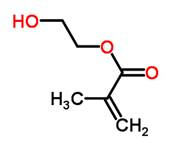预凝胶溶液是在1000μl试管中创建的;表1列出了材料、聚合作用和添加量。
| 材料 |
目的 |
结构 |
摩尔百分比 |
| 2,2-二甲氧-2-苯基-乙苯酚(DMPAP) |
免费读取器(光发器) |
 |
0.0012 |
| 2-羟基丙烯酸酯
(赫马)
|
聚合物骨干 |
 |
21.2121 |
| 四乙二醇二甲酸酯 (TEGDMA) |
交联器 |
 |
3.0303 |
| 乙二醇
(EG)
|
溶剂 |
 |
75.7576 |
表 1.水凝胶预凝胶成分,它们在水凝胶自由基聚合中的作用,化学2D聚合物结构,以及添加到预凝胶溶液中的量。
合成
- 在开始水凝胶合成之前,用两个玻璃玻片和三个520微米厚的聚烯烃片垫片组装了一个合成模具;此配置由活页夹保持在一起,如图6所示。大型玻璃玻片偏移几毫米,形成将预凝胶溶液移液到模具中的通道。
- 在开始水凝胶合成之前,获得1000μl试管,表1中描述的化学品,一个带清洁尖端的微移液器,并设置模具(图6)。所有工作都应在烟气罩内使用适当的个人防护设备 (PPE) 进行。PPE 包括安全眼镜或护目镜、实验室外套和防护手套。

图6:水凝胶合成模具,由两个玻璃玻片、三条520微米厚的聚烯烃片制成垫片,以及大型活页夹。
- 首先将0.0012摩尔百分比2,2-二甲氧基-2-苯基-乙苯酚(DMPAP),固体光敏启动器(由光启动的自由基启动器)添加到试管中。
- 加入21.2121摩尔%2羟基丙烯酸丙烯酸酯(HEMA),骨干分子,和3.0303摩尔%四乙二醇二甲丙烯酸酯(TEGDMA),将分子交联到试管,每次使用新的移液器尖端。TEGDMA 通过将聚合物链连接到网络聚合物中,在自由基存在的情况下将 HEMA 链进行化学交联。
- 使用涡旋机混合溶液,直到达到均质溶液。
- 测量 0.25 克溴化二醇紫色,并使用溶剂 75.7576 摩尔百分比乙二醇 (EG) 将其冲洗到溶液中。颜料仅用于观察目的(否则水凝胶是透明的),EG用作溶剂,溶解启动的自由基启动器,并保持水凝胶的弹性。
- 使用涡旋机混合溶液,直到颜料完全溶解,溶液均匀。
- 使用微移液器,通过将微移液器的尖端与大玻璃玻片的偏移边缘对齐,并将预凝胶溶液均匀地注入模具中心,将溶液放入模具中。
- 将模具放置在紫外线手电筒(Warson SK66)下方 5 厘米处,并照射模具一分钟。紫外线会收缩发起器物种的键,使它们变成自由基,然后攻击聚合物和交联分子。完全联网时,水凝胶应为具有 jello 状一致性的橡胶固体。
- 从灯中取出模具并拆卸模具配置。从玻璃玻片中取出水凝胶。
- 用去离子水冲洗水凝胶的两侧,以去除产品中的任何未反应的化学种类和寡聚物。
- 为了描述各种紫外线照射时间如何影响交联和膨胀能力的程度,此过程可以在变化步骤 9 时重复。对于表征,溶液暴露在紫外线下1分钟,1.5分钟和5分钟,共产生三个水凝胶。
表征
水凝胶的膨胀程度可以通过干燥、保湿,然后重新干燥聚合物来计算。
- 将成品水凝胶放入装有酒精(如同丙醇)的容器中,以便完全浸没。当酒精已取代水凝胶中的所有乙二醇时,在醇中离开 4-8 小时。
- 从酒精中取出水凝胶,在露天晾干,约30分钟。酒精蒸发速度比水或溶剂快,使水凝胶保持其结构。
- 称量干狗。
- 将水凝胶浸入DI水中至少30分钟,直到它们完全肿胀。从水中取出凝胶,轻轻擦干并称重。
- 使用等式计算膨胀程度:
 ,肿胀
,肿胀 聚合物的重量和
聚合物的重量和 干聚合物的重量在哪里。
干聚合物的重量在哪里。





 ,肿胀
,肿胀 聚合物的重量和
聚合物的重量和 干聚合物的重量在哪里。
干聚合物的重量在哪里。












